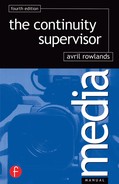Continuity Report Sheet: Technical
Roll Numbers
Note down the camera and sound roll numbers if shooting on film. If shooting on videotape, note the tape reel number.
Interior or Exterior
Mark whether you are shooting an interior or an exterior scene and note the weather, if exterior. Just ‘dull’ or ‘sunny’ will suffice.
Sound Details
Stereo
With the almost universal use of stereo sound in finished films and television programmes, the PA should ideally log what sort of sound is taken for each shot.
M&S
In a stereo production, this could be M&S, which stands for mono and stereo – a system whereby one track on the recording machine is used to record a mono sound signal, and the other to record a stereo or width signal. The two signals are combined in post production to produce a final A + B stereo sound track.
A&B
Or the sound could be recorded A&B, which means basically left and right stereo as finally heard by the viewer on their television set.
Mono
Sometimes on a stereo production, the recordist will shoot the sound mono to achieve clarity, for example, in dialogue. This will be combined in post production with a stereo atmosphere, either recorded on location as a wildtrack or taken from a library effect.
Dual Mono
In some situations the location recordist may decide to record twin track mono sound (not to be confused with stereo). A good example of this is a conversation between two people each of whom is wearing a personal radio microphone. It is frequently better for the voices to be combined in post production by the dubbing mixer than mixed on location.
If shooting on film, the next thing to note down relates to sound. Is the shot taken sync – that is, with camera and sound ‘locked’ together and running synchronously? Or is it to be a silent or ‘mute’ shot (with no sound recording being made)? If the sound is being recorded without shooting a picture, this is known as a ‘wild track’, sometimes written as ‘wildtrack’. The expression ‘wildtrack with camera’ means that the sound is recorded simultaneously with the shooting of the picture but with no interlock between camera and recorder. All under– and over-cranked shots which have sound recorded for them at the same time fall into this category.
‘Guidetrack’ indicates that the camera and sound are running in sync: the sound is intended only as a guide to the editor and is not of good enough quality to be used in the completed film.
‘Playback’ is the term used where sound is played into the shot as a guide for the actor’s movements. In a pop video, for example, an actor might mime the song to playback.
Shooting on Videotape
If shooting on videotape, the camera will not be run at varying speeds. However, although a sound track is automatically recorded on videotape, it is still possible to have a mute shot – in other words there is no sound on the soundtrack. Conversely, it is still possible to record a wildtrack. However, as it is necessary to record some sort of picture for technical reasons when making ‘sound only’ recordings on videotape, it is immensely helpful to the editor if a shot, however rough, is taken of the microphone while the wildtrack is being recorded, as it visually identifies the sound as being a wildtrack.
